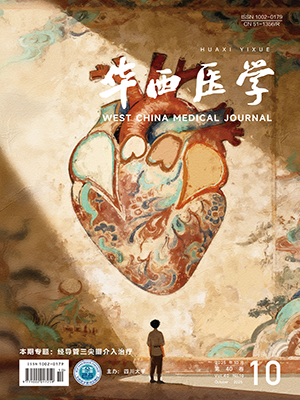| 1. |
Siegel R, Naishadham D, Jemal A. Cancer statistics, 2013[J]. CA Cancer J Clin, 2013, 63(1):11-30.
|
| 2. |
Lin Y, Totsuka Y, He Y, et al. Epidemiology of esophageal cancer in Japan and China[J]. J Epidemiol, 2013, 23(4):233-242.
|
| 3. |
Cox JD, Stetz J, Pajak TF. Toxicit y criteria of the radiation therapy oncology group (RTOG) and the European orqanization for research and treatment of cancer (EORTC)[J]. Int J Radiat Oncol Biol Phys, 1995, 31(5):1341-1346.
|
| 4. |
祝淑钗, 沈文斌, 李任, 等. 三维适形放疗食管癌所致放射性肺炎相关因素分析[J]. 中华放射医学与防护杂志, 2007, 27(2):161-164.
|
| 5. |
Trott KR, Herrmann T, Kasper M. Target cells in radiation pneumopathy[J]. Int J Radiat Oncol Biol Phys, 2004, 58(2):463-469.
|
| 6. |
Molteni A, Wolfe LF, Ward WF, et al. Effect of an angiotensin Ⅱ receptor blocker and two angiotensin converting enzyme inhibitors on transforming growth factor-beta (TGF-beta) and alpha-actomyosin (alpha SMA), important mediators of radiation-induced pneumopathy and lung fibrosis[J]. Curr Pharm Des, 2007, 13(13):1307-1316.
|
| 7. |
Murray LA, Chen Q, Kramer MS, et al. TGF-beta driven lung fibrosis is macrophage dependent and blocked by Serum amyloid P[J]. Int J Biochem Cell Biol, 2011, 43(1):154-162.
|
| 8. |
Hill RP, Zaidi A, Mahmood J, et al. Investigations into the role of inflammation in normal tissue response to irradiation[J]. Radiother Oncol, 2011, 101(1):73-79.
|
| 9. |
许泽苹, 林连兴, 许少生, 等. 食管癌三维适形放疗中肺损伤的相关因素分析[J]. 当代医学, 2011, 17(26):109-110.
|
| 10. |
Dang J, Li G, Lu X, et al. Analysis of related factors associated with radiation pneumonitis in patients with locally advanced non-small-cell lung cancer treated with three-dimensional conformal radiotherapy[J]. J Cancer Res Clin Oncol, 2010, 136(8):1169-1178.
|
| 11. |
Graham MV, Purdy JA, Emami B, et al. Clinical dose-volume histogram analysis for pneumonitis after 3D treatment for non-small cell lung cancer (NSCLC)[J]. Int J Radiat Oncol Biol Phys, 1999, 45(2):323-329.
|
| 12. |
Tsujino K, Hirota S, Endo M, et al. Predictive value of dose-volume histogram parameters for predicting radiation pneumonitis after concurrent chemoradiation for lung cancer[J]. Int J Radiat Oncol Biol Phys, 2003, 55(1):110-115.
|
| 13. |
Rodrigues G, Lock M, D'souza D, et al. Prediction of radiation pneumonitis by dose-volume histogram parameters in lung cancer:a systematic review[J]. Radiother Oncol, 2004, 71(2):127-138.
|
| 14. |
赵快乐, 施学辉, 蒋国梁. 用剂量体积直方图评估放射性肺损伤[J]. 中华放射肿瘤学杂志, 2002, 11(1):69-70.
|
| 15. |
Mccurdy M, Mcaleer MF, Wei W, et al. Induction and concurrent taxanes enhance both the pulmonary metabolic radiation response and the radiation pneumonitis response in patients with esophagus cancer[J]. Int J Radiat Oncol Biol Phys, 2010, 76(3):816-823.
|
| 16. |
Kong FM, Hayman JA, Griffith KA, et al. Final toxicity results of a radiation-dose escalation study in patients with non-small-cell lung cancer (NSCLC):predictors for radiation pneumonitis and fibrosis[J]. Int J Radiat Oncol Biol Phys, 2006, 65(4):1075-1086.
|
| 17. |
Asakura H, Hashimoto T, Zenda S, et al. Analysis of dose-volume histogram parameters for radiation pneumonitis after definitive concurrent chemoradiotherapy for esophageal cancer[J]. Radiother Oncol, 2010, 95(2):240-244.
|
| 18. |
Marks LB, Spencer DP, Sherouse GW, et al. The role of three dimensional functional lung imaging in radiation treatment planning:the functional dose-volume histogram[J]. Int J Radiat Oncol Biol Phys, 1995, 33(1):65-75.
|




